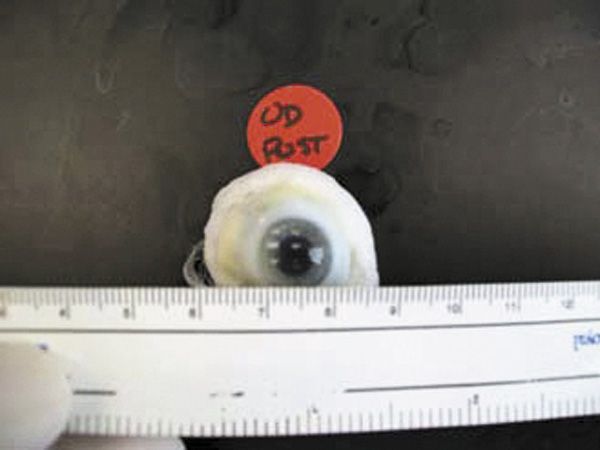Article
Meaningful pharmacologic pupil dilation possible after death
Pupils can be pharmacologically dilated after death, according to the results of a recent study. The study examined pupillary dilation of postmortem eye bank eyes, which may facilitate postmortem examination and screening through modalities such as fundus photography and fundus optical coherence tomography.
Take-Home
A valuable screening tool, pupillary dilation of postmortem eyes has been studied to facilitate examinations of ocular diseases after death.
Pupils can be pharmacologically dilated after death, explains Jeffrey R. Golen, MD, Department of Ophthalmology, University of South Florida, Tampa. (Video courtesy of Jeffrey R. Golen, MD)
Seattle-Pupils can be pharmacologically dilated after death, according to the results of a recent study.
The study examined pupillary dilation of postmortem eye bank eyes, which may facilitate postmortem examination and screening through modalities such as fundus photography and fundus optical coherence tomography (OCT).
“Pupillary dilation of postmortem eyes should lead to easier and more effective postmortem fundus photography and OCT,” said Jeffrey R. Golen, MD, at the annual meeting of the Association for Research and Vision in Ophthalmology. “This may be useful for eye banks for screening specimens for specific research interests.”
Potential applications of this protocol may even extend to postmortem diagnoses for clinicians and forensic examinations for other purposes, explained Dr. Golen, Department of Ophthalmology, University of South Florida, Tampa.
He gave the example of abusive head trauma (previously termed “shaken baby syndrome”) as a diagnosis that may potentially be aided or expedited with postmortem pupillary dilation.

(Figure 1a) Pre-dilation photograph of a globe taken 24 hours after time of death (Subject H).

Figure 1b) 60 minutes post-dilation in the same eye. (Images courtesy of Jeffrey R. Golen, MD)
Testing the protocol
In collaboration with the Lions Eye Institute for Transplant and Research (LEITR), Dr. Golen and colleagues tested a protocol for postmortem pupillary dilation and evaluated the effectiveness of topical mydriatic agents on fresh, non-preserved eye bank eyes. The investigators reviewed pre-death records that included patient demographics, medical and ocular histories, and medications, if available.
The eyes were also evaluated for iris color or other iris abnormalities. Initial ocular photographs were taken before dilation and focused on the pupillary margin. The photographs included a millimeter ruler placed near the eye. The investigators then placed two drops of a solution of 10% phenylephrine and 1% tropicamide on the corneal surface. These drops were repeated twice, 3 minutes apart.
In seven eyes, the drops were instilled before the eye was procured from the orbit and in another seven eyes after procurement. Similar photographs of the eyes were taken 20 and 60 minutes after drug application, again with the same millimeter ruler adjacent to the globe.
Dr. Golen measured the pupils in the photographs and recorded the diameters at the various time points for post-hoc analysis. Fourteen cadaver eyes of eight subjects (five women, three men; average age, 72.6 years) were included. The irises were brown in seven eyes, blue in six eyes, and hazel in one eye. No eyes had had apparent iris trauma, iris melanoma, evidence of iritis, or visible iridoschisis. Two subjects had a history diabetes mellitus, including one who was legally blind.
Pupillary dilation results
Dilation was achieved in cadaver eyes up to 24 hours after time of death, Dr. Golen noted. Total pupillary dilation ranged from 0.7 to 2.6 mm in a heterogeneous group of unfixed tissue bank eyes, with a range of iris colors. Dilation also occurred across both study groups: those eyes with dilating drops applied after death but before procurement, and those eyes with dilating drops applied after procurement.
“Our group has developed a very simple protocol, which resulted in some degree of postmortem pupillary dilation in all 14 of the heterogeneous eyes studied,” Dr. Golen said. “Knowledge of this phenomenon, as well as a simple protocol to attain it, is exciting and may be useful in many areas of ophthalmic research where ocular human tissue plays an essential role.”
The effectiveness of the topical mydriatic agents on the bank eyes was likely aided by the prompt recovery and high quality of tissue provided by LEITR, Dr. Golen concluded.

Dr. Golen
Jeffrey R. Golen, MD
Dr. Golen has no financial interest in any aspect of this study. The Lions Eye Institute for Transplant and Research, Tampa, FL, sponsored and funded the study and provided the specimens.
Subscribe to Ophthalmology Times to receive the latest clinical news and updates for ophthalmologists.
Newsletter
Don’t miss out—get Ophthalmology Times updates on the latest clinical advancements and expert interviews, straight to your inbox.




